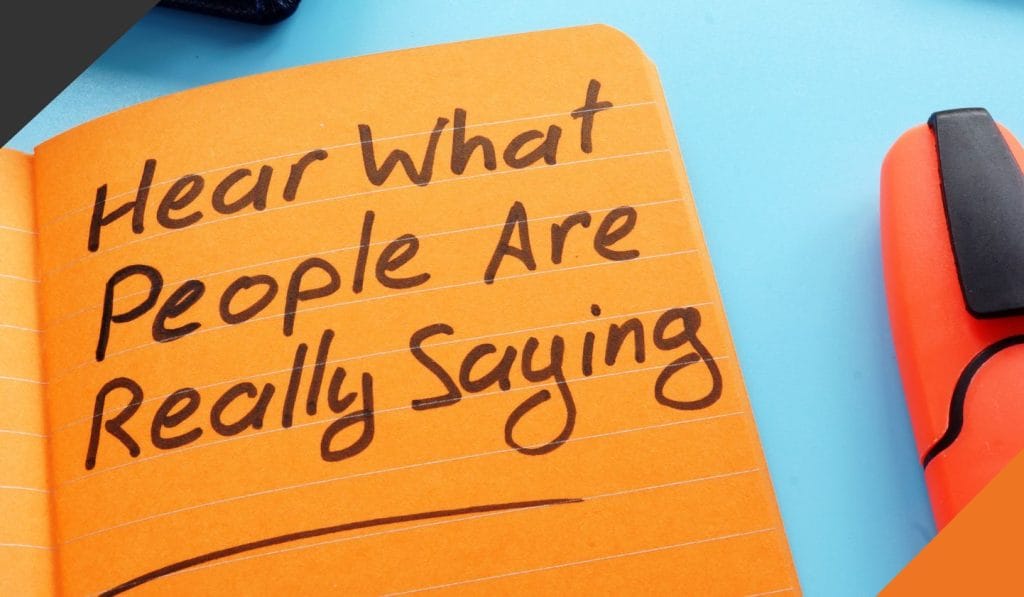
Today in our series of 12 tips on navigating difficult conversations, we examine a skill often overlooked in resolving conflicts and enhancing understanding: active listening. Ever found yourself in a conversation that felt more like a battle, each party armed with points and counterpoints, leaving no room for actual communication? It’s a common scenario, one that underscores the need for a shift in how we engage with each other.
Active listening is not merely about hearing words but about truly understanding the message, emotions, and unspoken truths conveyed. But why focus on active listening, especially in the context of difficult conversations?
The answer lies in its transformative potential. Active listening has the power to turn a confrontation into a moment of connection, misunderstanding into empathy, and conflict into collaboration. It’s about peeling back the layers of emotion and message to find the core of what’s being communicated.
Ready to learn how you can harness the power of active listening in your next challenging conversation? Stay with us as we explore actionable strategies, real-world applications, and insights into overcoming common obstacles.
The Role of Active Listening in Conflict Resolution
You are in the middle of a heated debate. Voices rise, and tension mounts. Now, pause. Shift gears to active listening. It’s like opening a window in a stuffy room. Suddenly, there’s clarity, understanding blooms, and empathy takes root. Active listening isn’t just about nodding along. It’s about truly grasping the essence of what’s being said, peeling back layers of emotion and uncovering the real message beneath.
Why does this matter in conflict resolution? Because most disputes stem from misunderstandings. When you actively listen, you’re not just waiting for your turn to speak. You’re fully present, decoding not just words, but the emotions and unspoken truths behind them. This disarms defensiveness, paving the way for genuine dialogue.
Consider a colleague upset over a missed deadline. Instead of immediately defending your actions, you listen. You acknowledge their frustration. Suddenly, the conversation shifts from blame to collaboration. You’ve not only resolved a conflict but also strengthened a relationship. That’s the power of active listening. It transforms conflicts into opportunities for growth and connection.
Active Listening Strategies for Difficult Conversations
Navigating tough talks? Active listening is your compass. It’s not about silent agreement but engaging with empathy and focus. Here’s how to steer through thorny dialogues:
Building Understanding
Start by mirroring emotions and content. Say your teammate expresses concern over workload. Instead of jumping to solutions, echo their feelings. It sounds like you’re overwhelmed by the current project pace, is that right? This simple act shows you’re in tune with their feelings, not just the words.
Enhancing Relationships
Active listening does more than resolve a single issue; it weaves stronger bonds. By showing genuine interest in someone’s perspective, you’re laying bricks of trust and respect. It’s like saying, I value you and what you have to say, without actually saying it.
Facilitating Problem-solving
Here’s where active listening turns magical. By fully grasping the problem from the speaker’s viewpoint, you unlock new solutions. Imagine a team member is hesitant about a new policy. Instead of dismissing their concerns, you dig deeper. What aspects of the policy are causing worry? This leads to insights that might have been overlooked, crafting solutions that respect everyone’s needs.
Each strategy turns potential conflict into a moment of connection. Remember, the goal isn’t to win an argument but to foster understanding and collaboration.
Overcoming Challenges in Active Listening
Active listening sounds straightforward, right? Yet, it’s often easier said than done. Distractions, preconceptions, and our own emotions cloud the process. Let’s tackle these hurdles head-on.
Distractions: They’re everywhere. From the ping of a notification to the thoughts buzzing in your head about your next meeting. The trick? Make a conscious choice to be present. Imagine turning down the volume on the world around you to amplify the person in front of you. It’s like focusing the lens on a camera to capture a clear, sharp image.
Preconceptions: We all have them. They shape our reactions and lead us to misunderstand. Challenge yourself to set aside these biases. Approach each conversation with a clean slate, as if you’re hearing about a concept for the first time. It’s akin to tasting a dish without knowing the ingredients, allowing the flavors to surprise you.
Emotional Reactions: Sometimes, what’s being shared might trigger you. It’s natural. Acknowledge your emotions but don’t let them take the wheel. Picture yourself as a detective, gathering facts with neutrality. Your goal? To understand, not to judge or react.
Remember, active listening is a skill honed over time. Mistakes are part of the learning curve. Each conversation is a new opportunity to practice, refine, and master this art. The rewards? Deeper connections, resolved conflicts, and enriched interactions. Keep at it, and watch the transformation unfold in your relationships and conversations.
The Heart of the Matter
We’ve walked through the power of active listening for diffusing conflict and navigating difficult conversations. Perhaps you’re sitting there, reflecting on past conversations, thinking, If only I had known this sooner. It’s a common sentiment, one that echoes the universal wish for deeper connections and the yearning to be truly heard.
You’re not alone in this. We’ve all experienced moments of disconnect, wishing for a bridge to mutual understanding. This is where the magic of active listening comes into play. It’s more than a skill; it’s a gift you offer to others and, importantly, to yourself.
Imagine the doors could open, the relationships could flourish, and the conflicts could find resolution, all from the simple act of listening—really listening. It’s a journey worth embarking on, with each conversation a step towards a more empathetic, connected world.
Remember: the world needs more listeners like you. Listeners who dare to dive deep into the heart of conversations, transform them into symphonies of understanding and connection.



